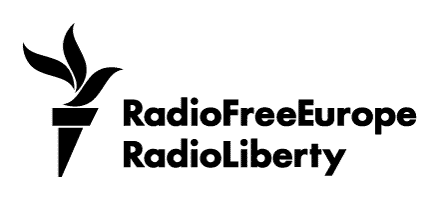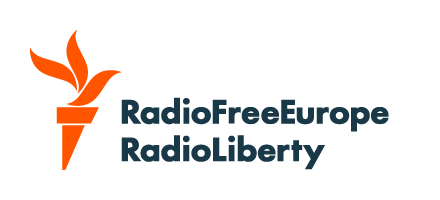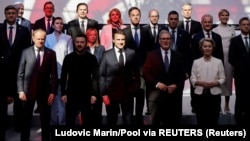Welcome to Wider Europe, RFE/RL's new newsletter focusing on the key issues concerning the European Union, NATO, and other institutions and their relationships with the Western Balkans and Europe's Eastern neighborhoods.
I'm RFE/RL Europe Editor Rikard Jozwiak, and this week I am drilling down on the uncertain path of the "coalition of the willing" forming a potential military mission to Ukraine, and the efforts by European allies to define what post-cease-fire security support in Ukraine could look like.
Assembling A 'Reassurance Force'
Among diplomats, Ukraine's "coalition of the willing" is jokingly referred to as "the coalition of the waiting."
Formed in early March to establish a military mission to Ukraine to support a peace plan ending Russia's full-scale invasion of its neighbor, now in its fourth year, there have been few details of what the coalition -- a loose grouping of largely European NATO nations as well as countries such as Australia, Canada, Japan and New Zealand -- exactly has in mind.
Earlier this month, a joint French-British technical team traveled to Ukraine to assess the needs of Kyiv for a "reassurance force." And on April 10 the defense ministers of the coalition met at NATO headquarters in Brussels for the first time.
The same coalition is expected to meet at the leaders' level on May 9 in Kyiv.
Despite all the gatherings and fanfare, very little, if anything, has in fact been decided, largely because there are too many unknowns at this stage. What will a potential cease-fire look like? What role, if any, would the United States play? And even if few Western officials want to admit this: What are the rules of engagement?
The European diplomats RFE/RL has spoken to under the condition of anonymity described the initial weeks of the group as "prudent planning," "getting our ducks in a row," or coming up with "what-if scenarios."
"Or, what-when [scenarios], if you want me to be more optimistic," added one diplomat.
Questionnaires And Answers
Paris and London -- which is very much taking the wheel in this process -- sent out a questionnaire on April 11 to all members, asking them which capabilities their country would be willing to deploy to Ukraine: How many airplanes, ships, drones, or even boots on the ground could be available at short notice?
The answers were due on April 18, and, once tallied, some sort of concrete timelines and scenarios could theoretically emerge.
To be fair, there are a few contours already.
Diplomats tell me the working assumption is that deployment would be for five years. It's ambitious, but the plan is for the first troops to be in Ukraine 72 hours after a full cease-fire is announced. They wouldn't, however, go anywhere near the conflict zone.
One diplomat told me there would likely be a buffer zone around a frozen contact line -- perhaps observed by the United Nations -- followed by a line of Ukrainian soldiers and then, far from any front, a contingency of the coalition of the willing.
Securing The Skies
There are varying ideas floating around what such a contingency can do.
One option on the table is that it would guard critical infrastructure in Western Ukraine. More specifically, it would create a "safe zone" around Lviv for airplanes to land. For this potential air component, both France and the United Kingdom have strong enough air forces, but also a country like the Netherlands could potentially contribute.
"If we talk about safe skies, of course we know that with the current capacity of Ukraine they are not able to do that alone, so they need support in this," Dutch Defense Minister Ruben Brekelmans told RFE/RL on the sidelines of the recent coalition meeting in Brussels.
"It's relatively easy to say how much countries can commit," he added. "In the Netherlands we have F-35s, for example, and we know of course how much capacity our F- 35s have and how many we can deploy. So that's not the difficult part; the difficult part is setting up the whole mission and making clear what the air element is going to do."
An even more ambitious idea being floated is for the coalition to be present at what one European official referred to as the "flanks" -- meaning near the Belarusian border or around Odesa.
The former would make sense with a view of the expected big "Zapad" exercises this autumn with a large number of Russian troops expected in Belarus.
A placement in Odesa, however, could be connected to the maritime component that so far seems the most developed aspect of the plans so far.
At the meeting in Brussels on April 10, Turkey declared it was ready to assume responsibility in this area. Essentially Ankara would continue to keep grain routes open for Ukrainian and international ships, potentially clear mines in the Black Sea, and take charge of being the framework nation for a future multinational maritime force in the region.
How Many Foreign Troops Would Be In Ukraine?
The diplomats RFE/RL spoke to mentioned a figure of around 30,000 boots on the ground, although it was footnoted as "an ideal number that might be hard to reach."
Such a number is essentially two full military divisions, but ideally another 90,000 would be needed to provide a rotational reserve.
Can the coalition really assemble anything close to that?
The problem is that most countries are remaining noncommittal due to all the uncertainty surrounding prospects of any cease-fire between Russia and Ukraine.
France and the United Kingdom are leading the push, and the Baltic trio of Estonia, Latvia and Lithuania are onboard, as well. Then there are nations like Belgium, Denmark, and the Netherlands, which are described as "forward-leaning." Germany is tied up at the moment with building its own government coalition, but there is hope that if Berlin eventually commits, others will fall in line.
"Russia hawks" like the Czech Republic and Poland are looking to their upcoming respective elections later this year, and some frontline states are saying they'd rather keep their military leaders closer to home than sending them east.
One diplomat confided to RFE/RL after the Brussels summit that most countries are not really "revealing their cards."
"They're attending the meetings, but they're rather in listening mode and perhaps add that they are supporting the endeavor in very general terms," they told me.
Russia And The United States
The two elephants in the room are the United States and Russia. While France, according to diplomats, is adamant no so-called American backstop is needed for a potential mission, others are more hesitant. They say US enablers are needed in at least two areas: logistics and intelligence.
In short, the Europeans can't carry out larger-scale missions without American help -- think of the moving of troops and the air cargo needed to transport military equipment quickly. And while both Britain and France have good intelligence, Washington is the one who can share advanced satellite images.
US President Donald Trump has so far refused to provide any assurances that the United States will back up European efforts. At the same time, though, European diplomats note that it's hard for America to commit to anything when the Europeans don't even have a proper plan in the first place.
What About Article 5?
But Washington's potential involvement goes far beyond satellite images and air lifts, at least according to Hanno Pevkur, Estonia's defense minister, who spoke to RFE/RL on April 10.
"When we talk about the backstop, when we talk the enablers, then it's the question about how to secure the forces and what will be the response if something happens," he said. "This is why we have to be very clear that no soldier will go to any battle -- whether it is a Ukrainian soldier or a European soldier from some other countries -- when they don't know what they can do. And when they do something, do they have the cavalry behind their back, helping them if there is a necessity?"
Most of this comes down , ultimately, to Russia and the rules of engagement. If Moscow fires at a Western mission, will they return fire or run? Even though it isn't a NATO mission, there is talk that a reassurance force of NATO countries could be covered by the military alliance's mutual defense clause, Article 5.
Does this mean a full-scale NATO-Russia war would break out if they were targeted? One ambassador told RFE/RL that Article 5 doesn't necessarily mean a full-scale response, but rather could be a targeted one such as hitting Russian positions in the occupied part of Ukraine.
The Porcupine Option
For many, this is playing with fire. And again, it's far from certain whether the United States would be onboard with any of these options.
Instead, officials are betting on an alternative plan for Ukraine -- for the moment, at least: the porcupine option. This means arming Ukraine to the teeth so it can withstand future Russian attacks or even deter the Kremlin completely from ever attacking again.
"The only question now is not how many European forces will be in Ukraine but what weapons and finances will be delivered to the Ukrainian military that currently consists of hundreds of thousands of troops that will be defending Ukraine from a future aggression," one European military planner put it to RFE/RL.
Another diplomat with insight into the talks noted something similar when it comes to supporting Kyiv: "Many countries are increasingly seeing this as the best option, instead of potentially risking their own soldiers to die in Ukraine."
Looking Ahead
This week the exhumation of the remains of Poles massacred by Ukrainian nationalists during World War II will resume in western Ukraine after a standstill in the process that has lasted since 2017.
The Volhynia massacres took place between 1943 and 1945, resulting in an estimated 100,000 dead.
Contrasting interpretations of the events have caused plenty of tensions between Poland and Ukraine, with Warsaw even threatening to block Kyiv’s path to EU membership over the issue. However, in late 2024, Ukraine announced that the exhumations can resume and that the two countries will increase cooperation on the issue.
That's all for this week!
Feel free to reach out to me on any of these issues on X @RikardJozwiak, or on e-mail at jozwiakr@rferl.org.
Until next time,
Rikard Jozwiak
If you enjoyed this briefing and don't want to miss the next edition subscribe here








